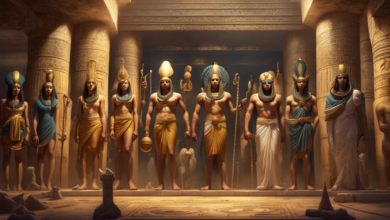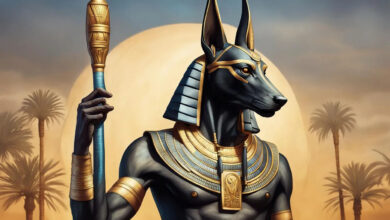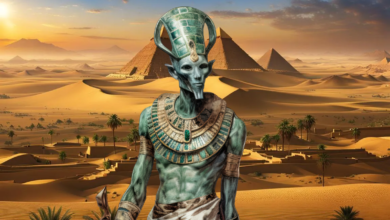The Radiant God of the Sun
In the heart of the scorching Egyptian desert, where the sun blazed fiercely across the vast expanse of sand, reigned Ra, the magnificent god of the sun. His worship, deeply ingrained in Egyptian culture for millennia, embodied the life-giving power of the sun, the ruler of the sky, and the essence of creation itself.
A Dazzling Image: Ra’s Many Forms
Ra was most commonly depicted as a majestic human figure with the head of a falcon, symbolising kingship and power. Ra’s image exuded an aura of authority and divine might, often adorned with a golden sun disk, adorned with a cobra (representing royalty) and a uraeus (a rearing cobra).
However, Ra wasn’t confined to a single form. He was also depicted as a lion, symbolising strength and ferocity, or as a ram, embodying fertility and creation. In his solar boat, traversing the celestial waters, he took the form of a scarab beetle, pushing the sun across the sky. These diverse representations reflected Ra’s power’s multifaceted nature and influence over every aspect of life.
The Solar Cycle: Ra’s Daily Journey
The Egyptians viewed the sun as a giant fiery boat traversing the celestial Nile. Every morning, Ra, reborn anew, emerged from the eastern horizon, battling the forces of darkness and chaos personified by Apophis, a monstrous serpent. His journey across the sky, a vast expanse of blue known as Nut, represented the daily cycle of light and dark, order and chaos.
At dusk, Ra would enter the underworld, the realm of the dead, where he transformed into another form, often depicted as a ram-headed god named Atum. Ra would face trials and battles in the underworld, mirroring the daily struggle for light to prevail over darkness. Finally, triumphant, he would be reborn in the east, ready to renew the cycle again.
A Life-Giving Force: Ra’s Role in Creation
Ra was considered the source of all life. His scorching rays warmed the earth, nurtured crops, and sustained all living beings. He was seen as the world’s creator, who brought order out of chaos in the primaeval state. The Egyptians believed that the pharaoh, the earthly ruler, embodied Ra on earth, drawing legitimacy and power from this divine connection.
Cult Centers and Rituals
The worship of Ra was central to Egyptian life. Grand temples were dedicated to him across the land, particularly prominent in Heliopolis, considered the sun god’s primary cult centre. Elaborate rituals were performed daily to ensure Ra’s continued journey across the sky. Priests chanted hymns, offered sacrifices, and performed symbolic acts to ensure the sun’s daily rebirth and the continued well-being of the land.
Merging with Amon: The Rise of Amun-Ra
Over time, Ra’s worship merged with that of another powerful deity, Amon, the god of the air. This combined form, Amun-Ra, became the supreme deity of the New Kingdom, representing the ultimate source of creation and power. This fusion symbolised the merging of two forces – the life-giving sun and the all-encompassing air – representing the very essence of existence.
Beyond the Sun: Ra and the Afterlife
Ra’s influence extended beyond the realm of the living. He was believed to play a role in the afterlife. The deceased hoped to join Ra on his journey through the underworld, escaping the clutches of darkness and achieving a blissful existence in the afterlife.
A Legacy of Light: Ra’s Enduring Influence
The worship of Ra may have faded with the decline of ancient Egypt, but his legacy continues to resonate. The image of the sun god remains a powerful symbol, representing creation, light, and the ongoing cycle of life and death. The enduring fascination with Ra offers a glimpse into the intricate belief systems of the ancient Egyptians and their profound respect for the forces that shaped their world.





